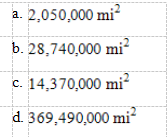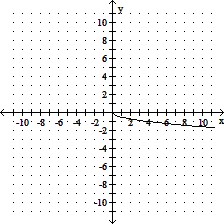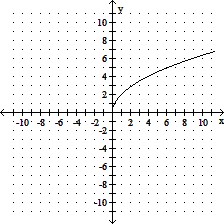Find the remaining sides and angles of the triangle ABC, with right angle at C. Round to the nearest tenth if necessary.B = 30.7°, a = 2.7
A. A = 59.3°, b = 3.3, c = 4.3
B. A = 59.3°, b = 1.6, c = 3.1
C. A = 59.3°, b = 0.5, c = 2.7
D. A = 59.3°, b = 3.3, c = 3.1
Answer: B
You might also like to view...
Determine whether function f represents exponential growth, exponential decay, linear growth or linear decay. Find a formula for f.
A. Exponential decay; f(x) = 10(-6.5)x B. Linear growth; f(x) = 3.5x + 10 C. Linear decay; f(x) = -3.5x + 10 D. Exponential growth; f(x) = 10(3.5)x
The area of a spherical polygon of n sides on a sphere of radius r is given by  where ? is the sum of the measures of the angles of the polygon in degrees. Use the formula to find the area of a spherical quadrilateral with angles of 84°, 84°, 111°, and 111° on the Earth, which has a radius of 1980 miles. Round to the nearest 10,000 square miles.
where ? is the sum of the measures of the angles of the polygon in degrees. Use the formula to find the area of a spherical quadrilateral with angles of 84°, 84°, 111°, and 111° on the Earth, which has a radius of 1980 miles. Round to the nearest 10,000 square miles.

Express the phrase as a ratio in lowest terms.90 cm to 60 cm
A. 
B. 
C. 
D. 
Graph the radical function. Compare the graph to that of the square root function or cube root function.g(x) = 2

A. It looks like the graph of the square root
function, but it is stretched by a factor of 2
and reflected over the x-axis.
B. It looks like the graph of the square root
function, but it is stretched by a factor of 2
and reflected over the x-axis.
C. It looks like the graph of the cube root
function, but it is stretched by a factor of 2.
D. It looks like the graph of the square root
function, but it is stretched by a factor of 2.